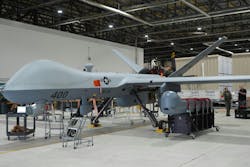Navy taps GALT for uncrewed aircraft networking node to enable MQ-9 Reaper UAV cross-domain communications
Questions and answers:
- What is the purpose of the SkyTower II pod developed by GALT Aerospace? It transforms the MQ-9 Reaper UAV into a high-end communications node with real-time data and voice relay across air, land, and sea for cross-domain communications for the U.S. Navy and Marine Corps.
- How does the SkyTower II pod improve military operations? It supports secure communications and data-sharing among different military units, particularly in distributed operations like the Marine Air-Ground Task Force.
- When is the first deployment of the SkyTower II pod expected? In 2026 by the Marine Unmanned Aerial Vehicle Squadron 3 (VMU-3) at Kaneohe Bay, Hawaii.
PATUXENT RIVER NAS, Md. – U.S. Navy and Marine Corps uncrewed aircraft communications experts needed an airborne networking payload that transforms the MQ-9 uncrewed aerial vehicle (UAV) into a high-end communications node. They found a solution from Global Air Logistics and Training (GALT) Aerospace Inc. in San Diego.
Officials of the Naval Air Systems Command at Patuxent River Naval Air Station, Md., announced a $145.5 million contract to GALT Aerospace last week as many as 20 Airborne Network Extension SkyTower II (STII) pod systems.
The SkyTower II pod is an airborne network-extension system developed for the MQ-9 Reaper that enhances cross-domain communications for the U.S. Navy and Marine Corps. It enables real-time data and voice relay among disparate forces across air, land, and sea.
SkyTower II provides secure communications and data-sharing across different military units, and helps coordinate among air, ground, and naval forces for distributed operations like the Marine Air-Ground Task Force.
Uncrewed ISR system
The system enables the MQ-9 uncrewed aircraft to act as an intelligence, surveillance, and reconnaissance (ISR) system that fuses information from several different sources and extends tactical situational awareness over great distances, Navy officials say.
Network Bridge and Gateway: Functions as a network gateway, retransmitting, cross-banding, and translating data across otherwise incompatible networks and secure waveforms, supporting both on-board sensors and off-board users.
Designed for use in large contested geographic areas like the Indo-Pacific, SkyTower II supports persistent operations by making the most of the MQ-9 30-hour endurance and the reach of its advanced payloads.
Tell me more about using uncrewed aircraft as networking nodes ...
- Using uncrewed aerial vehicles (UAVs) as networking nodes taps into the ability of drones to provide mobile, flexible, and scalable communication networks in remote or disaster-stricken areas regions, or where rapid deployment of communication systems is needed. Drones can establish communication networks quickly by changing positions based on real-time network demand. Drones can be deployed more quickly than traditional base stations or repeaters for military operations where network capacity needs to be enhanced on short notice. Drones also can operate at higher altitudes than traditional ground-based communication systems to offer wider coverage in areas with difficult terrain. Drones can serve as relays or flying base stations that extend existing networks or create ad-hoc networks The use of drones as networking nodes is still in the early stages of development, but rapid advancements in drone technology, 5G, and satellite communication are pushing the boundaries of what’s possible.
GALT Aerospace developed SkyTower II together with Sierra Nevada Corp. in Sparks, Nev. First integrated onto the MQ-9 in February 2025, initial operational capability (IOC) is expected by the end of this year for the U.S. Marine Corps. Marine Unmanned Aerial Vehicle Squadron 3 (VMU-3) at Kaneohe Bay, Hawaii, will be the first to deploy SkyTower II in 2026.
SkyTower II is 154.2 inches long, 20.9 inches wide, 28.4 inches high, and weighs 459 pounds, and is optimized for extended-endurance UAVs like the Reaper. It will enable MQ-9s to serve as relay and command nodes for expeditionary and distributed Navy/Marine Corps operations The Navy’s MQ-9 Reaper test squadron at Patuxent River NAS received the first SkyTower II pod last February.
For more information contact GALT Aerospace online at www.galt.aero/skytowerii.
About the Author
John Keller
Editor-in-Chief
John Keller is the Editor-in-Chief, Military & Aerospace Electronics Magazine--provides extensive coverage and analysis of enabling electronics and optoelectronic technologies in military, space and commercial aviation applications. John has been a member of the Military & Aerospace Electronics staff since 1989 and chief editor since 1995.
